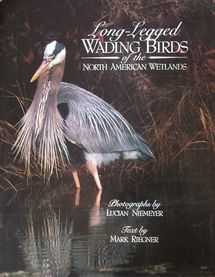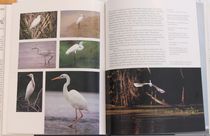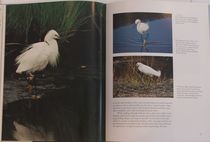Reviewed by Grant McCreary on November 10th, 2007.
In general, herons and egrets are very popular with birders and non-birders alike. They are exquisite, elegant, beautiful, and obvious. That latter characteristic is one of the most important. Indeed, these birds are nearly impossible to miss in places such as Florida. Even in the most crowded theme parks you can find several representative species and often in great numbers. I remember being fascinated with these birds as a kid, and that has continued into my birding life. One of my first birding highlights was finding and identifying my first Green Heron. Nevertheless, there are more “long-legged wading birds” than just the herons. Even though most do not know these birds as well, they are equally fascinating. This book serves as an introduction to these birds, as well as the wetlands that they inhabit.
This book covers the following 20 species:
- Herons – Great Blue, Little Blue, Tricolored, Green
- Egrets – Great, Snowy, Reddish, Cattle
- Night-Herons – Black-crowned and Yellow-crowned
- Bitterns – American and Least
- Ibises – White, Glossy, White-faced
- Wood Stork
- Roseate Spoonbill
- Limpkin
- Cranes – Whooping and Sandhill
Most books similar to this one dedicate a separate chapter for each species. However, this one takes a different approach and organizes itself around the various aspects of the birds’ lives. The first chapter serves as an introduction to the birds and their habitat, focusing especially on their food and feeding behavior. This chapter has a unique arrangement. It focuses discretely on each of the 20 species as well as various types of wetlands, all the while flowing smoothly from one to the next without any sort of header or break in the narrative. For an example, here is the transition from Snowy Egret to Little Blue Heron:
As the white egret grooms, nearby its dark cousin stealthily pursues an aquatic meal. Unlike the quick actions of the Snowy, the Little Blue Heron uses slow, deliberate movements and pauses for long periods to peer at the water.
This technique could easily have been disastrous, but in actuality it was handled very well. The only drawback is that you are essentially limited to using the index if you want to find information about a particular species. Thankfully, the index is very detailed and for each species’ entry gives specific page numbers for breeding plumage, diet, feeding, habitat, nesting, and other such characteristics.
The remaining chapters cover the breeding cycle, migration, and conservation. The latter includes past problems, the current status, and the future outlook of the birds and wetlands. Overall, the book presents a good summary of these birds, although some species are covered better than others.
Not surprisingly, the book is now a little out-of-date in some respects since its publication in 1993. The most noticeable thing is the inclusion here of the “Green-backed Heron”, which you will not find in modern North American field guides. This is, of course, our Green Heron. The taxonomy of this genus is still debated, but the current thought is that what was the Green-backed Heron is now three species – Green Heron, Lava Heron (of the Galapagos, as mentioned in this book), and Striated Heron. In addition, since this was written there have been many developments with Whooping Cranes. The book mentions that a population had been introduced that migrates between Idaho and New Mexico. This flock no longer exists, and now conservationists are focused on another migratory population that breeds in Wisconsin and winters in Florida.
These birds are the epitome of picturesque. They could be the most photographed group of birds on the continent. The expectations for the photographs in any book on these species are quite high. Thus, it is a disappointment that the pictures here are certainly nice, but they don’t blow you away. Also, I would have liked more photos of courtship and young birds. However, one very welcome touch was an entire page contrasting all of the white herons and egrets, including the white morphs of Great Blue Heron and Reddish Egret, as well as the white immature Little Blue Heron. It made the differences in these birds much easier to see. In addition to the birds, photos of other animals that share their environment are also included, such as Raccoons and Alligators. There are also many pictures of various wetland habitats without birds or other animals present.
Captions accompany all of the photographs. Most of these reiterate information presented in the main text. This works fine most of the time, but given the large number of pictures it seems the authors simply ran out of things to say in some cases. For example, the caption for a Little Blue Heron photo that occurs almost half-way into the book reads “The heron family (Ardeidae) contains about sixty species world-wide, which are typically characterized by long legs, a long neck, and a saberlike bill.” While that is nice information to know, its placement in the middle of the book made it almost comical in its randomness.
The binding and pages are very high quality, but this volume is not quite a true coffee-table book. It is, however, an adequate introduction for those not very familiar with these wonderful birds. Moreover, if this is your favorite group of birds, then you cannot really go wrong with it. But for everyone else it is probably not detailed and in depth enough to warrant a recommendation.
Disclosure: I get a small commission for purchases made through links in this post.






[…] Review: Long-Legged Wading Birds of the North American Wetlands […]